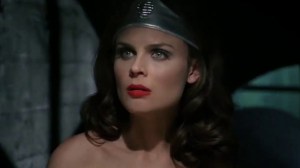And the Oscar for Visual Effects goes to… James Cameron’s Avatar: The Way of Water. The sequel to the highest-grossing film of all time took home the Academy Award for Best Visual Effects during the 95th Oscars Sunday, with gold going to production senior visual effects supervisor Joe Letteri, WETA FX senior animation supervisor Daniel Barrett, and WETA FX visual effects supervisors Richard Baneham and Eric Seindon. For the win, Disney/20th Century Studios’ Avatar 2 beat out Tom Cruise’s high-flying Top Gun: Maverick (Paramount Pictures), German-language war drama remake All Quiet on the Western Front (Netflix), DC’s dark and gritty Dark Knight reboot The Batman (Warner Bros. Pictures), and Marvel Studios superhero blockbuster Black Panther: Wakanda Forever (Walt Disney Pictures).
Videos by ComicBook.com
Cameron’s Avatar sequel went into the night with a total of four nominations, including Best Picture, Best Sound, and Best Production Design. The original 2009 Avatar also won the Best Visual Effects Oscar and took home awards for art direction and cinematography.
Since hitting U.S. theaters on December 16, Avatar: The Way of Water amassed $2.284 billion at the global box office to become the highest-grossing film of 2022 and recently surpassed Cameron’s own Titanic to become the third highest grosser ever, behind only Avatar ($2.922 billion) and Avengers: Endgame ($2.797 billion).
In returning to the world of the Na’vi on Pandora, Cameron and WETA FX spent years perfecting the technology to capture the film’s underwater scenes through motion capture and visual effects.
“It’s never been done before and it’s very tricky because our motion capture system, like most motion capture systems, is what they call optical base, meaning that it uses markers that are photographed with hundreds of cameras,” Cameron explained in a 2017 interview. “The problem with water is not the underwater part, but the interface between the air and the water, which forms a moving mirror. That moving mirror reflects all the dots and markers, and it creates a bunch of false markers.”
Cameron continued: “It’s a little bit like a fighter plane dumping a bunch of chaff to confuse the radar system of a missile. It creates thousands of false targets, so we’ve had to figure out how to get around that problem, which we did. Basically, whenever you add water to any problem, it just gets ten times harder. So, we’ve thrown a lot of horsepower, innovation, imagination and new technology at the problem, and it’s taken us about a year and a half now to work out how we’re going to do it.”
Last month, the film’s BAFTA-winning VFX team revealed only two shots in the 3-hour and 12-minute-long movie were created without any CGI.
“There’s one of Spider’s [Jack Champion] eyeball and there’s one of the bottom of the ocean and just some ripples in the bottom of the water,” Saindon told Metro. While some shots and sequences featured more grounded elements, Saindon confirmed that every other shot in the film was either “created or added to” by the visual effects team, while adding, “There’s lots of live-action, lots of characters with CG but every other scene, VFX shots were touched.”
Avatar: The Way of Water is now playing in theaters and is available to own March 28th on Digital HD with more than three hours of extras.








